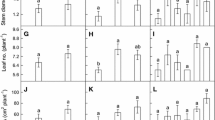Abstract
This paper is the second in a three-part series describing the influence of varied irradiance on growth and photoassimilate partitioning by potato plants. Four clones (Russet Burbank, Lemhi Russet, A66107-51, and A6948-4) were grown under two light regimes: a) high light levels (HL) of 500 to 1200 μE m-2 s-1, varying with changes in natural sunlight and time of day, and b) low light levels (LL) at approximately one quarter of high light (21 to 28%). Three weeks after tuber initiation, the most recently-matured leaf was labelled with14CO2, and plants were harvested: 1) one day after labelling, and 2) two weeks after labelling. Plants of all clones responded to the low light levels in a similar way by: 1) changing some morphological characteristics, 2) decreasing biomass accumulation and tuber yield, and 3) changing the sink-source relationship by promoting growth of leaves and stems at the expense of tubers. However, there were evident clonal differences in reactions to growth under low light; e.g., Lemhi Russet appeared to be most sensitive to light stress, while clones A66107-51 and A6848-4 were much less sensitive. No matter what the prior light history (HL or LL), clone A6948-4 was able to maintain higher rates of photosynthesis than the other clones at all light levels between 200 and 1200 μE m-2 s-1. This study showed that the potential exists to breed for cuttivars that can maintain higher rates of photosynthesis and higher tuber yield under low light levels.
Similar content being viewed by others
Literature Cited
Chapman, H.W. 1951. Absorption of CO2 by leaves of the potato. Am Potato J 28:602–615.
Chapman, H.W. and W.E. Loomis. 1953. Photosynthesis in potato under field conditions. Plant Physiol 28:703–716.
Dwelle, R.B., G.E. Kleinkopf, R.K. Steinhorst, JJ. Pavek and P.J. Hurley. 1981. The influence of physiological processes on tuber yield of potato clonesSolanum tubero- sum L.: Stomatal diffusive resistance, stomatal conductance, gross photosynthetic rate, leaf canopy, tissue nutrient levels and tuber enzyme activities. Potato Res 24:33–47.
Dwelle, R.B., P.J. Hurley and J.J. Pavek. 1983. Photosynthesis and stomatal conductance of potato clones(Solarium tuberosum L.) Plant Physiol 72:172–176.
Gawronska, H. and R. B. Dwelle. 1989. Partitioning of photoassimilates by potato plants(Solarium tuberosum L.) as influenced by irradiance. I. Partitioning patterns in cultivar Russet Burbank grown under high and low irradiance. Am Potato J 66:201–213.
Ku, S., G.E. Edwards and C.B. Tanner. 1977. Effect of light, carbon dioxide, and temperature on photosynthesis, oxygen inhibition of photosynthesis and transpiration inSolanum tuberosum. Plant Physiol 59:886–872.
Menzel, C.M. 1982. The control of tuberization in potato(Solanum tuberosum L.) at high temperatures. Ph.D. Thesis, University of Queensland. Dept. of Botany, pp. 227–235.
Menzel, C.M. 1985. Tuberization in potato at high temperatures: Interaction between temperatures and irradiance. Ann Bot 55:33–39.
Moll, A. 1980. Die Photosyntheserate wS.hrend der Entwicklung de1- Kartoffelpflanze. Potato Res 23:319–326.
Moll, A. and W. Henninger. 1978. Genotypishe Photosyntheserate yon Kartoffeln und ihre mögliche Rolle für Ertragsbildung. Photosynthetica 12(1):51–61.
Nösberger, J. and E.C. Humphries. 1965. The influence of removing tubers on dry matter production and net assimilation rate of potato plants. Ann Bot N.S. 29(116):579–588.
Sale, P.J.M. 1973. Productivity of vegetable crops in a region of high solar input. I. Growth and development of the potato(Solanum tuberosum L.). Austr J Agric Res 24:733–749.
Sale, P.J.M. 1974. Productivity of vegetable crops in a region of high solar input. III. Carbon balance of potato crops. Austr J Plant Physiol 1:283–296.
WinNer, E. 1971. Potato cultivation in Tyrol. II. Photosynthetic efficiency and respiration in different potato varieties. Potato Res 14:1–18.
Zrust, J. 1983. The photosynthetic rate in different potato genotypes. Rostl Vyroba 29(6):563–576.
Zrust, J. and A. Smolikova. 1977. Differences in assimilation rate in potato hybrids and in some parental varieties. Rostl Vyroba 23(7):723–732.
Author information
Authors and Affiliations
Additional information
Approved for publication by the Director of the Idaho Agric. Expt. Station as research paper No. 88736. Supported in part by the Idaho Potato Commission and by the United States Department of Agriculture Competitive Research Grant No. 59-2161-1-1-654.0.
Rights and permissions
About this article
Cite this article
Gawronska, H., Dwelle, R.B. & Pavek, J.J. Partitioning of photoassimilates by potato plants (Solanum tuberosum l.) as influenced by irradiance: II. Partitioning patterns by four clones grown under high and low irradiance1. American Potato Journal 67, 163–176 (1990). https://doi.org/10.1007/BF02987069
Accepted:
Issue Date:
DOI: https://doi.org/10.1007/BF02987069




